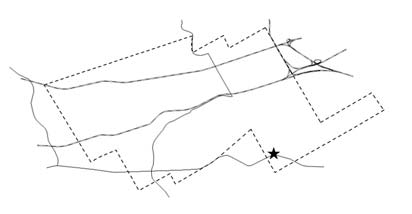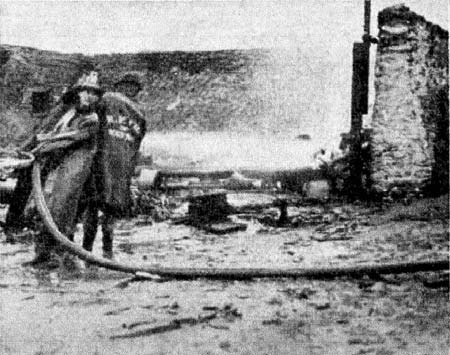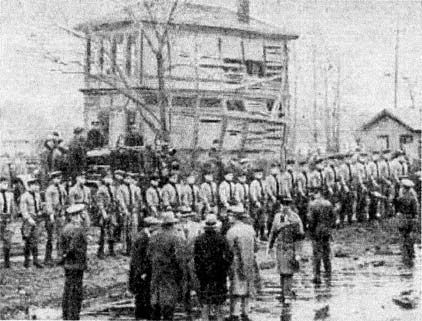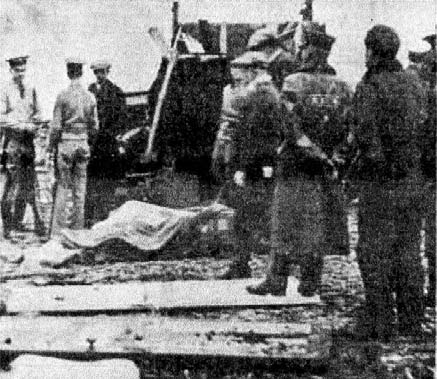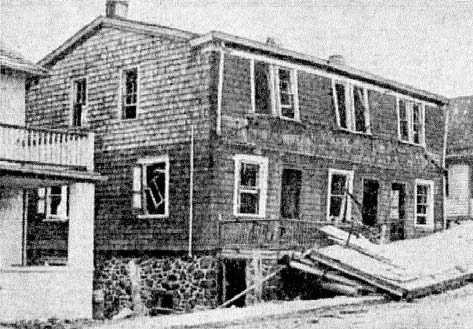|
Home : Quarterly Archives : Volume 44 |
Tredyffrin Easttown Historical Society |
|
Source: Winter/Spring 2007 Volume 44 Numbers 1&2, Pages 58–60 Scenes of Disaster at Devon
Noise from the blast, it was reported, was heard for 50 miles, in places as far away as Trenton, where the windows of the State House were rattled, and Wilmington. In southern New Jersey some people thought there had been an explosion at the DuPont plants along the Delaware River. Broken glass from the concussion was reported in West Philadelphia. Bits of red paper and other debris were found in Norristown. Windows were shattered in practically every building in Devon, as well as in hundreds of houses along the Main Line from Wayne to Berwyn. Countless homes were shaken: dishes broken, pictures tossed from the walls, candlesticks and other bric-a-brac toppled to the floor. Plaster was torn loose from ceilings and walls. People walking along the street were knocked off their feet; motorists on the Lancaster Pike were pushed off the road as if shoved by a sudden gust of wind. The cause of the blast was a series of tremendous and terrible explosions at the Pennsylvania Fireworks Display Company, Inc., located on the north side of Old Lancaster Road in Devon just north of the underpass where the road is crossed by the railroad tracks. At a few minutes after 10 in the morning of Thursday, 3rd April 1930, shortly after the delivery of 30 kegs of black powder, 3 devastating explosions, in quick succession, shook the plant. 10 people were killed and scores of others injured. A pall of smoke, illuminated from time to time by exploding fireworks, covered the valley as flames enveloped the remaining buildings on the property.
One of the principal owners of the company, Alexander Vardaro, was at the property with his son, secretary of the company, and his daughter at the time of the explosion, and was stunned by the blast, but escaped with only minor injuries.
Vardaro had been making fireworks in Devon for about 12 years, starting in 1918 on a small scale in the kitchens of the workers' homes. As the business grew, he built a small factory with several small frame shacks for storage on the 7 acre site. The operation was then known as the Devon Fireworks Company. By 1930 the plant, now the Pennsylvania Fireworks Display Company, had expanded to include 14 metal and frame buildings, including 8 larger buildings and 6 smaller five-foot square sheds. The smaller sheds were used for the storage of the various ingredients used in the manufacture of firecrackers, torpedoes, aerial bombs, pinwheels, rockets, and other fireworks the company produced. This was not the first explosion at the fireworks company. About two years earlier, in 1928, there was an explosion that blew the roof off a building and sent it into the road. The explosion also caused the building to catch fire. Fortunately, no one was in the building at the time, nor was anyone injured. However, the building was so badly damaged that it was never rebuilt. In 1929 complaints about the employment of minors also mentioned that there had been several small explosions. The Department of Labor response was that no violation of the law had been found.
But while the 1930 explosion may not have been the first on the site, it certainly was the last one. After the blast, the entire area was likened by army veterans to the No-Man's-Land of World War I. Every bit of vegetation was shattered and torn off. The force of the exploding fireworks and powder left great holes, like shell craters, in the black, pock-marked earth. Except for the office and one concrete foundation, there was not a timber projecting more than 2 feet above the ground to indicate where the buildings had been.
The proprietor of the site, Luigi Peruzzi of Devon, was one of the 10 people killed. Immediately after the blast firemen and fire trucks from all over the Main Line rushed to the scene in an attempt to try to control the ensuing fires. The exploding fireworks had scattered burning debris over a wide area, causing numerous field fires.
Other nearby buildings were also damaged or destroyed by the blast. Several small houses and residences along Old Lancaster Road, across from the fireworks company, were leveled, or damaged beyond repair. The Pennsylvania Railroad signaling system was put out of action, and a train stopped at Devon station had its windows shattered, injuring several passengers. It is believed that it was not just the chemicals that caused the explosion. A gas stove that was being used in the drying room was implicated in the large scale of the blast.
A community effort to help the victims of the blast was quickly put in place, and by the evening no one was in need of a place to sleep, nor lacked clothing, food, or other services. Later groups, such as the Boy Scouts, helped people clean up from what was one of the worst disasters ever experienced in the area—when the fireworks factory in Devon blew up. The township has recently purchased the site of the factory. It is planned to turn the location into a park. |
| Previous Article ⇐ ⇒ Next Article |


